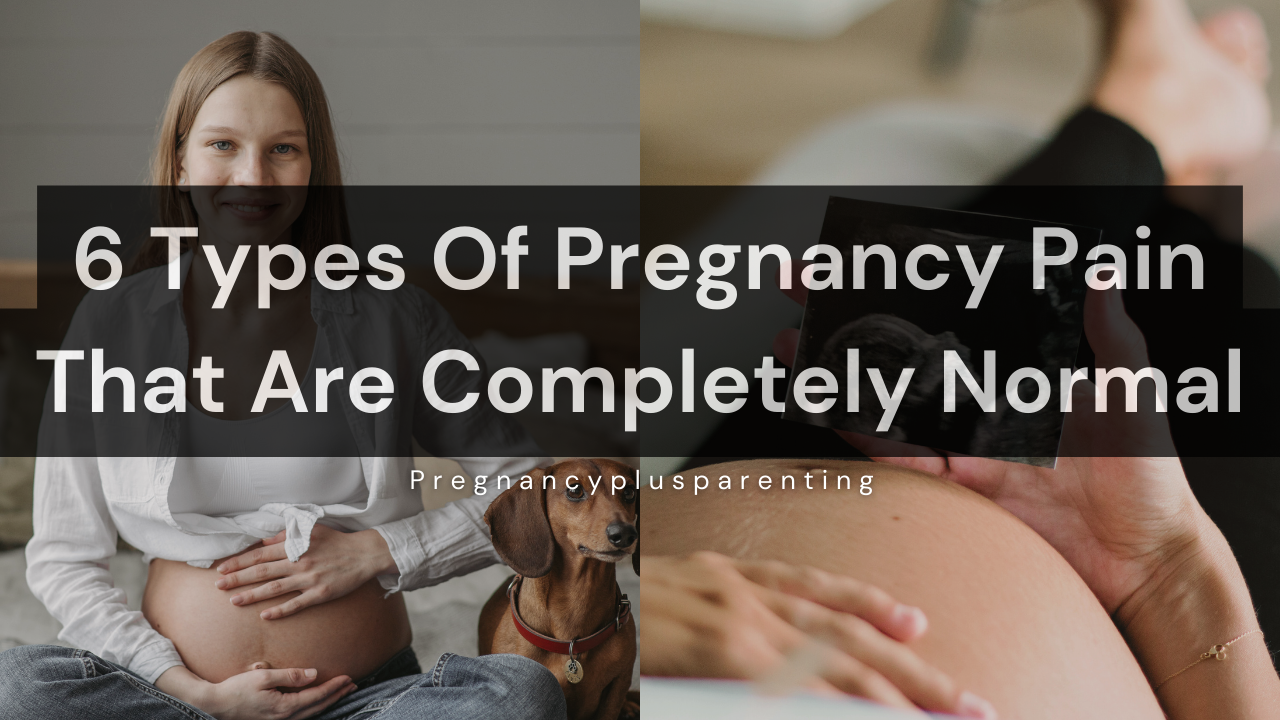6 Types Of Pregnancy Pain That Are Completely Normal
Pregnancy is a transformative journey filled with moments of joy, anticipation, and plenty of changes to the body. While it’s an exciting time, it can also come with discomfort and pain that might feel unfamiliar or worrying. The good news is that many types of pregnancy pain are entirely normal and just a part of your body adapting to support your growing baby. Understanding these pains can provide reassurance and help you manage them effectively.
In this guide, we’ll discuss six common types of pregnancy pain, why they happen, and how to cope with them.
Back Pain
Back pain is one of the most common discomforts during pregnancy, affecting nearly two-thirds of expectant mothers. It typically begins in the second trimester and can persist until delivery.
Why It Happens
As your baby grows, the weight of the uterus shifts your center of gravity forward, causing additional strain on your lower back. Pregnancy hormones like relaxin also loosen the ligaments in your pelvis to prepare for childbirth, which can destabilize your back and contribute to pain.
What It Feels Like
- A dull ache in the lower back.
- Sharp pain after standing for long periods.
- Tension in the upper back or shoulders.
How to Cope
- Exercise: Gentle prenatal yoga or swimming can strengthen your back muscles.
- Posture: Use supportive seating and practice standing upright to reduce strain.
- Heat Therapy: Applying a warm compress can alleviate soreness.
- Support Belts: Maternity belts provide additional support for your back.
Round Ligament Pain
Round ligament pain is a sharp, stabbing sensation in the lower abdomen or groin, often catching women off guard. It’s a natural side effect of your body making room for the growing baby.
Why It Happens
The round ligaments, which support your uterus, stretch as it expands during pregnancy. Sudden movements like coughing, sneezing, or standing too quickly can cause the ligaments to tighten, resulting in pain.
What It Feels Like
- A brief, sharp pain on one or both sides of the lower abdomen.
- A pulling sensation that lasts a few seconds.
How to Cope
- Move Slowly: Avoid sudden movements that can strain the ligaments.
- Stretching: Gentle stretches can improve flexibility and reduce discomfort.
- Rest: Take breaks during the day to reduce strain on your abdominal muscles.
Pelvic Pain
Pelvic pain, also known as pelvic girdle pain (PGP), is another common pregnancy-related discomfort. It can occur at the front or back of the pelvis and may worsen as your pregnancy progresses.
Why It Happens
Relaxin, the hormone that loosens ligaments for childbirth, can sometimes make the pelvic joints less stable, leading to pain. The extra weight of your growing baby and pressure on the pelvis also contribute.
What It Feels Like
- A dull ache in the pelvic region.
- Pain while walking, climbing stairs, or rolling over in bed.
- A clicking or grinding sensation in the pelvis.
How to Cope
- Pelvic Support Belts: These stabilize the pelvis and reduce discomfort.
- Low-Impact Exercise: Walking or water aerobics can improve strength without straining the pelvis.
- Physical Therapy: A therapist can teach you exercises to align the pelvis and relieve pain.
Leg Cramps
Leg cramps are sudden, painful muscle spasms that often occur at night during pregnancy. They can disrupt sleep and leave your legs feeling sore.
Why It Happens
The exact cause of leg cramps during pregnancy isn’t entirely clear, but contributing factors include reduced blood circulation, muscle fatigue from carrying extra weight, and possible dehydration.
What It Feels Like
- Intense, sharp pain in the calves or thighs.
- A tight, knotted sensation that can last a few seconds to a few minutes.
How to Cope
- Stay Hydrated: Drink plenty of water throughout the day.
- Stretching: Stretch your calves before bedtime to reduce the likelihood of cramps.
- Massage: Gently massage the affected area to relieve tension.
- Magnesium-Rich Foods: Incorporate foods like bananas, nuts, and leafy greens into your diet.
Sciatica
Sciatica is a shooting pain that starts in the lower back and travels down one leg. It occurs when the sciatic nerve, the largest nerve in the body, becomes compressed.
Why It Happens
The growing uterus and baby can press against the sciatic nerve, causing inflammation or irritation. Changes in posture and weight distribution during pregnancy can also contribute.
What It Feels Like
- Shooting or burning pain down one leg.
- Numbness or tingling in the lower back, buttocks, or legs.
- Weakness in the affected leg.
How to Cope
- Stretching Exercises: Gentle stretches like the pigeon pose can alleviate pressure on the sciatic nerve.
- Hot and Cold Therapy: Alternating heat and ice packs can reduce inflammation.
- Prenatal Massage: A trained therapist can help relieve tension in the affected areas.
- Sleep Positioning: Sleep on your side with a pillow between your knees for optimal alignment.
Breast Pain
Breast pain is a common early pregnancy symptom caused by hormonal changes and preparation for breastfeeding. It often eases after the first trimester but may persist for some women.
Why It Happens
Hormonal surges increase blood flow to the breasts and stimulate the growth of milk ducts. This leads to tenderness, swelling, and heightened sensitivity.
What It Feels Like
- Soreness or tenderness in the breasts.
- A heavy or full feeling.
- Nipples that are extra sensitive or sore.
How to Cope
- Supportive Bras: Invest in well-fitted maternity or sports bras to minimize discomfort.
- Cold Compresses: Apply a cold pack to reduce swelling and tenderness.
- Warm Showers: The warmth can provide soothing relief for achy breasts.
- Gentle Massage: Use a light touch to relieve tension and improve circulation.
When to Call Your Doctor
While these types of pain are normal during pregnancy, it’s important to know when to seek medical advice. Contact your healthcare provider if you experience:
- Severe or persistent pain that doesn’t improve with rest or home remedies.
- Sudden or sharp pain accompanied by bleeding, fever, or chills.
- Difficulty walking or significant swelling in the legs.
Listening to your body and consulting your doctor for reassurance can help ensure a healthy pregnancy for both you and your baby.
Why Pregnancy Pain Is Normal
Pregnancy is a natural but complex process where your body undergoes significant changes to accommodate a growing baby. Hormones like relaxin and progesterone surge to prepare your body for childbirth, often resulting in ligament softening and joint loosening. Your blood volume increases, your organs shift to make space for the uterus, and your posture adjusts due to the added weight.
All of these changes, while essential, place extra demands on muscles, bones, and ligaments, which can lead to discomfort. Understanding why these pains occur can reduce worry and help you embrace the process as part of your journey.
Tips for General Pain Management
While every type of pregnancy pain has specific remedies, there are general practices that can help you manage discomfort more effectively throughout your pregnancy.
1. Stay Active
Low-impact exercises like walking, swimming, or prenatal yoga improve circulation, strengthen muscles, and relieve tension. Staying active also boosts your mood, alleviating stress that can exacerbate pain.
2. Practice Good Posture
As your baby grows, maintaining proper alignment becomes increasingly important. Stand tall, keep your shoulders back, and avoid slouching to prevent strain on your back and pelvis.
3. Invest in Supportive Accessories
- Maternity Pillows: These can help support your back and belly while sleeping.
- Compression Stockings: Useful for improving circulation and reducing leg cramps.
- Comfortable Shoes: Wear flats or low heels with arch support to stabilize your stance.
4. Listen to Your Body
Pushing through discomfort can sometimes worsen the pain. If something doesn’t feel right, take a moment to rest or adjust your activity level.
5. Hydrate and Eat Well
Dehydration and nutrient deficiencies can intensify muscle cramps and fatigue. Drink plenty of water and focus on a balanced diet rich in magnesium, calcium, and potassium.
Exploring Emotional Connections to Pain
Pregnancy pain isn’t purely physical—it often intertwines with emotional well-being. For example, stress can exacerbate tension in the back or shoulders, while anxiety about childbirth may lead to headaches or general discomfort.
Mindfulness techniques like meditation or deep breathing exercises can help you stay calm and grounded. Prenatal classes that combine relaxation techniques with education about labor and delivery can also reduce stress and improve your overall comfort.
The Social Side of Pregnancy Pain
Pregnancy pain, though common, can sometimes feel isolating, especially if you’re unsure whether what you’re experiencing is normal. Building a support network of friends, family, or other expectant mothers can help you share experiences and find reassurance.
Consider joining prenatal support groups or attending childbirth preparation classes. Talking with others going through the same journey can validate your feelings and provide valuable tips for managing discomfort.
Long-Term Benefits of Managing Pregnancy Pain
Effectively managing pain during pregnancy isn’t just about short-term relief; it sets the stage for better postpartum recovery. Maintaining strength, flexibility, and proper alignment helps reduce the risk of post-delivery complications like chronic back pain or pelvic misalignment.
Additionally, building healthy habits during pregnancy—such as prioritizing rest, gentle exercise, and good nutrition—can make the transition into motherhood smoother, allowing you to focus more on bonding with your baby.
Busting Myths About Pregnancy Pain
Pregnancy pain often comes with myths or misconceptions that can make expectant mothers unnecessarily worried. Let’s debunk a few:
1. Myth: Pain Means Something Is Wrong
Truth: Mild to moderate pain is usually a normal part of pregnancy. It’s your body adjusting to its new demands. However, severe or persistent pain should be discussed with your doctor.
2. Myth: You Shouldn’t Exercise If You’re in Pain
Truth: In most cases, gentle movement can actually alleviate pain. Activities like stretching or swimming reduce tension and promote better blood flow.
3. Myth: Pain Will Vanish After Delivery
Truth: While many pregnancy-related pains subside after childbirth, some, like back pain, may linger if not addressed during pregnancy. Taking preventive measures now can help you feel better in the long run.
Understanding Pain in the Third Trimester
The third trimester often brings more pronounced discomfort as your baby reaches its full size. Here’s how to manage some specific pains during this period:
Braxton Hicks Contractions
Also known as “practice contractions,” these are irregular, mild contractions that prepare your body for labor.
- Coping Tip: Drink water, as dehydration can trigger Braxton Hicks. Resting or changing positions can also help them subside.
Pressure on the Bladder
As the baby descends into the pelvis, you may feel added pressure on your bladder and pelvic floor.
- Coping Tip: Practice pelvic floor exercises, like Kegels, to strengthen the area and improve bladder control.
Swelling in the Feet and Ankles
Swelling, or edema, is common as your body retains extra fluid in preparation for delivery.
- Coping Tip: Elevate your feet when sitting, avoid standing for long periods, and wear compression socks for relief.
When Pregnancy Pain Becomes a Sign of Labor
Some late-pregnancy pains may indicate that your baby is preparing to arrive. Look for signs like:
- Increased pelvic pressure.
- Regular contractions that grow stronger and closer together.
- Lower back pain accompanied by cramping.
If you’re unsure whether you’re in labor, don’t hesitate to contact your healthcare provider for guidance.
Finding Joy in the Journey
While pregnancy pain can be challenging, it’s also a reminder of the incredible process your body is undergoing. Each ache, cramp, or twinge is part of a journey that leads to the ultimate reward: holding your baby in your arms.
By understanding these normal pains and knowing how to manage them, you can navigate pregnancy with greater confidence and comfort. Embrace the support of loved ones, lean into self-care, and remember that every step brings you closer to meeting your little one.






